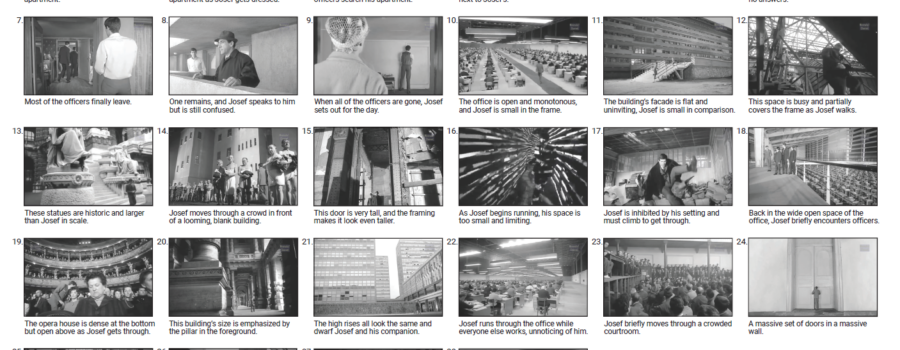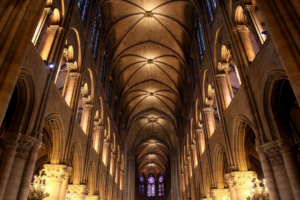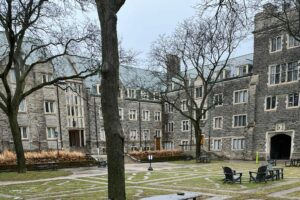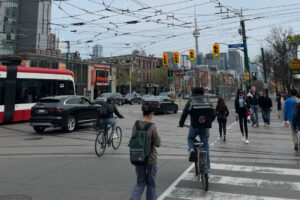Click here to view the project
Orson Welles’ film The Trial (1962) is based on a book of the same name by Franz Kafka. The story follows a man named Josef who is charged with a crime but does not know what it is. He is allowed to work and go about his life during the day, never detracting from his input to capitalism. However, he is eventually sentenced to death and killed: he never discovers his crime. My retreatment relates his experience to Fredric Jameson’s text on late capitalism and postmodernism. The text was rich with concepts and potential perspectives to analyze the film through, but what stood out to me was the idea that the postmodern built environment is out of scale with the human occupant and represents a greater confusion with one’s place in society.
This concept is expressed in the following quotation:
This latest mutation in space—postmodern hyperspace—has finally succeeded in transcending the capacities of the individual human body to locate itself, to organize its immediate surroundings perceptually and cognitively to map its position in a mappable external world. This alarming disjunction point between the body and its built environment … can itself stand as the symbol and analogon of that even sharper dilemma which is the incapacity of our minds, at least at present, to map the great global multinational and decentered communicational network in which we find ourselves caught as individual subjects.[1]
With this in mind, I present Josef’s experience of confusion and unsettlement about the officers and his crime in connection with the built environment around him. The retreatment begins with the inciting conflict of the story: Josef’s discovery of his charges. It is a montage of the officers arriving at Josef’s apartment and his interactions with them. I show a black screen while the music starts so that the first officer’s arrival is more sudden. The clips that follow have some smooth transitions between them but are mostly jarring, which reflects the unexpected nature of the officers’ appearance and interrogation. I chose to present Josef getting dressed throughout this as his attempt to have some control and get his bearings. He also retaliates against the officers and sends them out, but one remains and he still gets no answers. This sets up his confusion and displacement in his environment.
Once the officers leave, Josef is allowed to set out from his apartment and begin his day. The retreatment then becomes a montage of Josef moving through various spaces without a clear plot or direction. I put stronger emphasis on smooth transitions that line up with his framing in the shot so that the sets blend together, furthering his lack of clear location. Welles had a mastery of the camera and the film features some incredibly varied camera angles, which also contributed to the disorientation. This meant that the film already had a wealth of rich scenes to select from. I selected clips that are not linear within the plot to complicate the ability to place oneself: Josef cannot locate himself in space, nor is he clearly located in time. Most of the spaces in the film are monumental and imposing, dwarfing Josef as he moves through. The buildings tower over him and he seems insignificant in comparison. I focused on these buildings in my retreatment but also included some small spaces to show that Josef’s environment could be out of scale in both directions: too big and too small all at once. I did group a few scenes, such as Josef descending flights of stairs and running through rooms, to present some variety in his experience. However, it ultimately amounts to nothing.
As Josef moves through his environment, various characters appear alongside him but their presence is not explained. Sometimes Josef is with another character, alone, or in a crowd, but he is never really connected to them. This retreatment is centred around Josef’s experience, so the other characters are largely irrelevant. The only other characters that have a role in the retreatment are the officers at the beginning and end. I wanted to keep the overarching plot of the film in the retreatment because I believe that it connects well with the concepts of postmodernism and late capitalism, but I removed most of the details of the plot. The approximate three-act structure remains in the retreatment but is changed in a way that highlights the architectural connections to the concepts.
Finally, Josef’s confusion reaches its climax as the officers take him away and blow him up. I paralleled the beginning, when he gets dressed to gain control, by showing him undressing, presenting his loss of what little control he had. In the desert and the pit, he is also out of scale: the officers rise high above him, but there are no shots that show all three characters so their distance is unclear. I chose not to show the actual explosion as it can be inferred, and the crossfade between Josef sitting and the smoke rising is a more powerful conclusion.
The music that I used for this retreatment is “Adagio d’Albinoni” by Jean Ledrut. This score was composed for the film and it fits the atmosphere of my retreatment. It is haunting but steady and does not change drastically throughout the selection, which relates to the extended feelings of confusion that are present.
Ultimately, this retreatment presents Josef’s confusion over his relation to his society and the law through a disconnect with his environment. The urban setting around him emphasizes this disconnect because it is so overwhelming and out of sync with his bodily scale. Though he constantly moves through it, never stopping, he cannot change his fate and meets his end without any clarity for his situation. This aligns with Jameson’s theory that the built environment of postmodern society is misaligned with the individual and reflects a greater disconnect with the wide-spanning networks that people exist within.
[1] Fredric Jameson, “The Cultural Logic of Late Capitalism,” in Postmodernism, or the Cultural Logic of Late Capitalism (North Carolina, USA: Duke University Press, 1992): 44.





